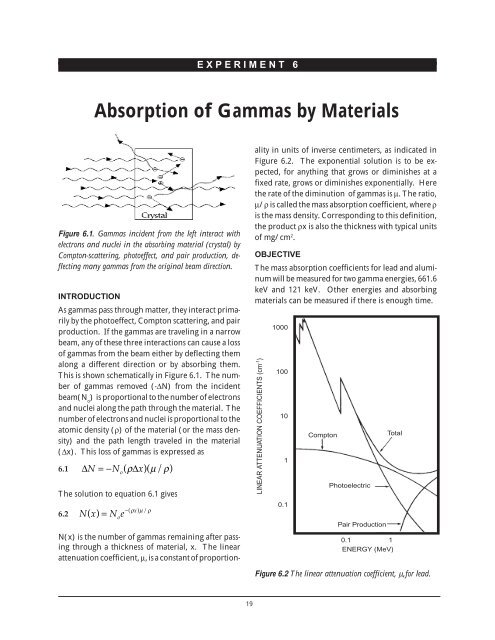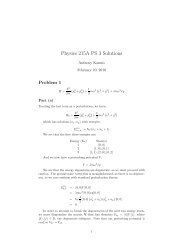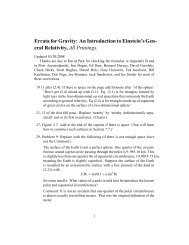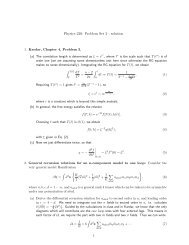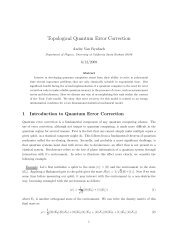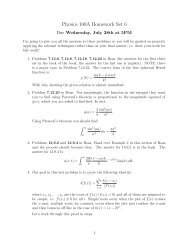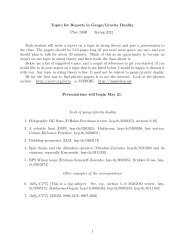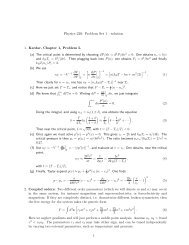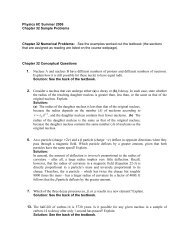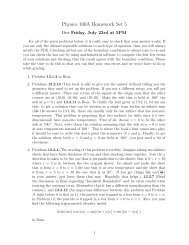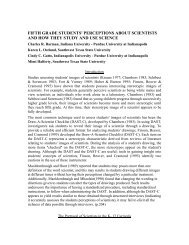Nuclear Spectroscopy
Nuclear Spectroscopy
Nuclear Spectroscopy
You also want an ePaper? Increase the reach of your titles
YUMPU automatically turns print PDFs into web optimized ePapers that Google loves.
E X P E R I M E N T 6<br />
Absorption of Gammas by Materials<br />
Figure 6.1. Gammas incident from the left interact with<br />
electrons and nuclei in the absorbing material (crystal) by<br />
Compton-scattering, photoeffect, and pair production, deflecting<br />
many gammas from the original beam direction.<br />
INTRODUCTION<br />
As gammas pass through matter, they interact primarily<br />
by the photoeffect, Compton scattering, and pair<br />
production. If the gammas are traveling in a narrow<br />
beam, any of these three interactions can cause a loss<br />
of gammas from the beam either by deflecting them<br />
along a different direction or by absorbing them.<br />
This is shown schematically in Figure 6.1. The number<br />
of gammas removed (-∆N) from the incident<br />
beam(N o<br />
) is proportional to the number of electrons<br />
and nuclei along the path through the material. The<br />
number of electrons and nuclei is proportional to the<br />
atomic density (ρ) of the material (or the mass density)<br />
and the path length traveled in the material<br />
(∆x). This loss of gammas is expressed as<br />
6.1<br />
The solution to equation 6.1 gives<br />
6.2<br />
∆N =− N ( ρ ∆x)( µ / ρ)<br />
Nx ( ) =<br />
o<br />
Ne o<br />
−( ρ x) µ / ρ<br />
N(x) is the number of gammas remaining after passing<br />
through a thickness of material, x. The linear<br />
attenuation coefficient, µ, is a constant of proportion-<br />
ality in units of inverse centimeters, as indicated in<br />
Figure 6.2. The exponential solution is to be expected,<br />
for anything that grows or diminishes at a<br />
fixed rate, grows or diminishes exponentially. Here<br />
the rate of the diminution of gammas is µ. The ratio,<br />
µ/ρ is called the mass absorption coefficient, where ρ<br />
is the mass density. Corresponding to this definition,<br />
the product ρx is also the thickness with typical units<br />
of mg/cm 2 .<br />
OBJECTIVE<br />
The mass absorption coefficients for lead and aluminum<br />
will be measured for two gamma energies, 661.6<br />
keV and 121 keV. Other energies and absorbing<br />
materials can be measured if there is enough time.<br />
LINEAR ATTENUATION COEFFICIENTS (cm -1 )<br />
1000<br />
100<br />
10<br />
1<br />
0.1<br />
Compton<br />
Photoelectric<br />
Pair Production<br />
Total<br />
0.1 1<br />
ENERGY (MeV)<br />
Figure 6.2 The linear attenuation coefficient, µ,for lead.<br />
19


